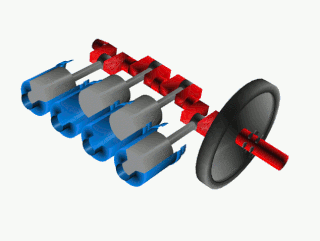
A crankshaft is a rotating shaft which converts reciprocating motion of the pistons into rotational motion. Crankshafts are commonly used in internal combustion engines and consist of a series of cranks and crankpins to which the connecting rods are attached.
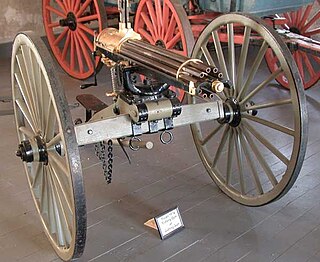
The Gatling gun is a rapid-fire weapon invented in 1861 by Richard Jordan Gatling and a forerunner of the modern machine gun. It is also a forerunner of the modern electric motor-driven rotary guns and rotary cannons.

A machine gun is a fully automatic firearm designed for rapid, sustained fire. Other fully automatic weapons, such as assault rifles and submachine guns, are not designed for sustained fire, and not considered machine guns.
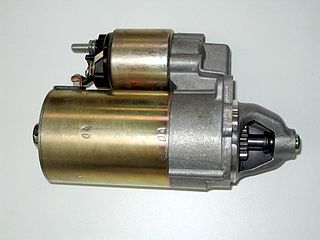
A starter is a device used to rotate (crank) an internal-combustion engine so as to initiate the engine's operation under its own power. Starters can be electric, pneumatic, or hydraulic. In the case of very large engines, the starter can even be another internal-combustion engine.

Terracotta, terra cotta or terra-cotta, a type of earthenware, is a clay-based unglazed or glazed ceramic, where the fired body is porous. Terracotta is the term normally used for sculpture made in earthenware, and also for various practical uses including vessels, water and waste water pipes, roofing tiles, bricks, and surface embellishment in building construction. The term is also used to refer to the natural brownish orange color of most terracotta, which varies considerably.

A straight-twin engine, also known as straight-two, inline-twin, vertical-twin, or parallel-twin is a two-cylinder piston engine which has its cylinders arranged side by side and its pistons connected to a common crankshaft. Compared to V-twins and flat-twins, straight-twins are more compact, simpler, and usually cheaper to make, but may generate more vibration during operation.
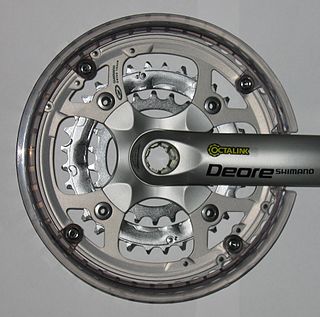
The crankset or chainset, is the component of a bicycle drivetrain that converts the reciprocating motion of the rider's legs into rotational motion used to drive the chain or belt, which in turn drives the rear wheel. It consists of one or more sprockets, also called chainrings or chainwheels attached to the cranks, arms, or crankarms to which the pedals attach. It is connected to the rider by the pedals, to the bicycle frame by the bottom bracket, and to the rear sprocket, cassette or freewheel via the chain.

A tile is a thin object usually square or rectangular in shape. A tile is a manufactured piece of hard-wearing material such as ceramic, stone, metal, baked clay, or even glass, generally used for covering roofs, floors, walls, or other objects such as tabletops. Alternatively, tile can sometimes refer to similar units made from lightweight materials such as perlite, wood, and mineral wool, typically used for wall and ceiling applications. In another sense, a tile is a construction tile or similar object, such as rectangular counters used in playing games. The word is derived from the French word tuile, which is, in turn, from the Latin word tegula, meaning a roof tile composed of fired clay.

A reciprocating saw is a type of machine-powered saw in which the cutting action is achieved through a push-and-pull ("reciprocating") motion of the blade.

A dropped ceiling is a secondary ceiling, hung below the main (structural) ceiling. It may also be referred to as a drop ceiling, T-bar ceiling, false ceiling, suspended ceiling, grid ceiling, drop in ceiling, drop out ceiling, or ceiling tiles and is a staple of modern construction and architecture in both residential and commercial applications.
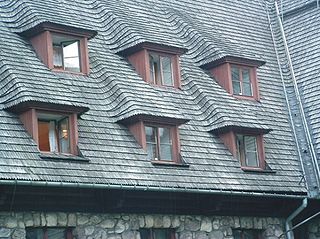
Roof shingles are a roof covering consisting of individual overlapping elements. These elements are typically flat, rectangular shapes laid in courses from the bottom edge of the roof up, with each successive course overlapping the joints below. Shingles are made of various materials such as wood, slate, flagstone, metal, plastic, and composite materials such as fibre cement and asphalt shingles. Ceramic roof tiles, which still dominate in Europe and some parts of Asia, are still usually called tiles. Roof shingles may deteriorate faster and need to repel more water than wall shingles. They are a very common roofing material in the United States.
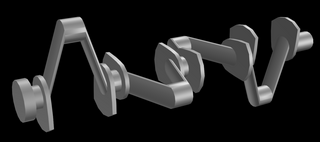
The crossplane or cross-plane is a crankshaft design for piston engines with a 90° angle between the crank throws. The crossplane crankshaft is the most popular configuration used in V8 road cars.

The flat-plane crank is a type of crankshaft for use in internal combustion engines that has a 180 degree angle between crank throws.

A masonry heater is a device for warming an interior space through radiant heating, by capturing the heat from periodic burning of fuel, and then radiating the heat at a fairly constant temperature for a long period. Masonry heaters covered in tile are called cocklestoves. The technology has existed in different forms, from back into the Neoglacial and Neolithic periods. Archaeological digs have revealed excavations of ancient inhabitants utilizing hot smoke from fires in their subterranean dwellings, to radiate into the living spaces. These early forms have evolved into modern systems.
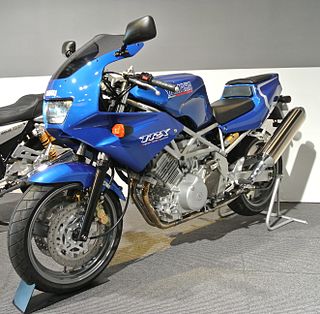
The Yamaha TRX850 is a sports motorcycle with a 10-valve DOHC 849 cc 270° parallel-twin engine. First released in Japan in 1995, a version for the European market was available from 1996 to 2000.

Crank: High Voltage is a 2009 American action film written and directed by Mark Neveldine and Brian Taylor. It is the sequel to the 2006 film Crank, and stars Jason Statham, Amy Smart, Clifton Collins Jr., Efren Ramirez, Bai Ling, David Carradine, and Dwight Yoakam. The story follows ex-hitman Chev Chelios, who, shortly after surviving a deadly fall on the streets of Los Angeles, is kidnapped and has his heart stolen by Chinese gangsters, replacing him with an artificial heart designed to keep him alive for an hour. Chev then sets out to find his heart while keeping himself electrically charged to stay alive. The film also features several cameo appearances of celebrities from various entertainment media.
A big bang engine is an unconventional motorcycle engine designed so that most of the power strokes occur simultaneously or in close succession. This is achieved by changing the ignition timing, changing or re-timing the camshaft, and sometimes in combination with a change in crankpin angle. The goal is to change the power delivery characteristics of the engine. A regular firing multi-cylinder engine fires at approximately even intervals, giving a smooth-running engine. Because a big-bang engine has uneven power delivery, they tend to run rougher and generate more vibration than an even-firing engine.
The Williams gun was a Confederate gun that was classified as a 1-lb cannon. It was designed by Captain D.R. Williams, of Covington, Kentucky, who later served as an artillery captain with a battery of his design. It was a breech-loading, rapid-fire cannon that was operated by a hand-crank. The barrel was four feet long and a 1.57-inch caliber. The hand crank opened the sliding breech which allowed the crew to load a round and cap the primer. As the crank was continued, it closed the breech and automatically released the hammer. The effective range was 800 yards but the maximum range was 2000 yards.

Roof tiles are designed mainly to keep out rain, and are traditionally made from locally available materials such as terracotta or slate. Modern materials such as concrete and plastic are also used and some clay tiles have a waterproof glaze.
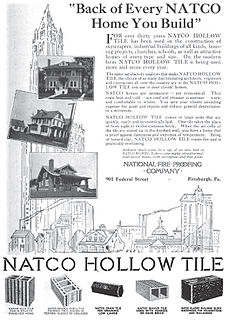
Structural clay tile describes a category of burned-clay building materials used to construct roofing, walls, and flooring for structural and non-structural purposes, especially in fireproofing applications. Also called building tile, structural terra cotta, hollow tile, and clay block, the material is an extruded clay shape with substantial depth that allows it to be laid in the same manner as other clay or concrete masonry. In North America it was chiefly used during the late 19th and early 20th centuries, reaching peak popularity at the turn of the century and declining around the 1950s. Structural clay tile grew in popularity in the end of the nineteenth-century because it could be constructed faster, was lighter, and required simpler flat falsework than earlier brick vaulting construction. Each unit is generally made of clay or terra-cotta with hollow cavities, or cells, inside it. The material is commonly used in floor arches, fireproofing, partition walls, and furring. It continues to be used in Europe to build fire-resistant walls and partitions. In North America the material has largely been replaced by concrete masonry units.

















